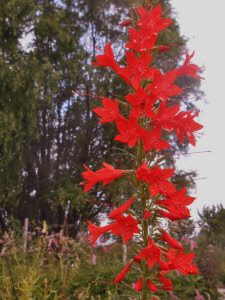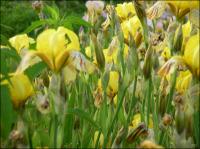Shop
Showing 425–432 of 785 results
-
Ipomopsis rubra Standing Cypress, Scarlet Gilia Z 5-9 Biennial
Red-orange trumpet-shaped blooms encircle 3-5’ tall spike from May-July
ARCHIVED
Note: This is a plant not currently for sale. This is an archive page preserved for informational use.
Red-orange trumpet-shaped blooms encircle 3-5’ tall spike from May-July
Size: 3-5’ x 3-6’
Care: sun in dry to moist, well-drained soil
Native: Oklahoma-South Carolina, Florida to Texas
Wildlife Value: attracts bees, Swallowtail butterflies and hummingbirds. Deer resistant.Described by Linnaeus in Species Plantarum 1: 163. 1753
-
Iris ‘Honorabile’ Z 4-9
Clear yellow standards with maroon striped-dashed falls
ARCHIVED
Note: This is a plant not currently for sale. This is an archive page preserved for informational use.
Clear yellow standards with maroon striped-dashed falls, blooms in mid-season
Size: 18-24" x 12"
Care: sun in moist well-drained soilFrench hybrid by Nicolas Lemon in 1840’s.
-
Iris ‘Monsignor’ syn. Anne’s Iris Z 3-9
Classic purple iris with sunny throat and white stripes on the beard, blossoms in late May to early June
Classic purple iris with sunny throat and white stripes on the beard, blossoms in late May to early June
Size: 15" x 8"
Care: moist well-drained soil in sun to part shadeThis Iris was growing in the gardens when we moved here in 1992. The property has been owned continuously by the Utter – Patterson family from 1880 until 1992. Anne Patterson began gardening here in 1927 as a young bride, so I call these “Anne’s Iris.” In June 2003 Anne turned 104 years old. She passed away on August 1. Hybridized at French nursery Vilmorin-Andrieux et Cie, a legendary seed house started in late 1700’s. Some firm members specialized in Irises from the 1880’s. The firm introduced ‘Monsignor’ in 1907, one of its earlier hybrids.
-
Iris ‘Spark’ Z 4-8
Early blooming, intermediate bearded iris of brick-red standards and burgundy falls with a bright spark of a beard in the middle.
Early blooming, intermediate bearded iris of brick-red standards and burgundy falls with a bright spark of a beard in the middle.
Size: 23” x 12”
Care: sun in moist well-drained soil.
Wildlife Value: Welcomes bees with easy access to pollen.Iris is named after the Greek goddess who accompanied the souls of women to the Elysian Fields by way of the rainbow. Her footprints left flowers the colors of the rainbow. Iris means the eye of heaven. The iris is the flower of chivalry, having “a sword for its leaf and a lily for its heart.” Ruskin. Spark hybridized and introduced by Col. J. C. Nicholls in 1931,
-
Iris ‘Wabash’ Z 3-8
Pure white standards with deep purple falls edged in white and a bright yellow beard in late May-early June. “A new iris so far in advance of others of similar color combination that they are simply not in the race.” Cooley’s Gardens catalog, 1938
Pure white standards with deep purple falls edged in white and a bright yellow beard in late May-early June. “A new iris so far in advance of others of similar color combination that they are simply not in the race.” Cooley’s Gardens catalog, 1938
Size: 39" x 8"
Care: sun in moist well-drained soil. In July-August lift & divide every 2 to 3 years; discard mushy rhizomes.
Wildlife Value: Deer and rabbit resistant.
Awards: Dykes award (best iris in world) winner 1940.Iris is named after the Greek goddess who accompanied the souls of women to the Elysian Fields by way of the rainbow. Her footprints left flowers the colors of the rainbow. Iris means the eye of heaven. The iris is the flower of chivalry, having “a sword for its leaf and a lily for its heart.
Hybridized by Mary Williamson in 1936, daughter of famed iris hybridizer E.B. Williamson. She became a renowned hybridizer in her own right. ‘Wabash’, is a cross of ‘Dorothy Dietz’ with ‘Cantabile.’ -
Iris ‘Polar King’ Z 4-9
Pure white with yellow falls, reblooming iris. Blooms spring and again in fall.
Pure white with yellow falls, reblooming iris. Blooms spring and again in fall.
Size: 34”x8” Vigorous & spreads by rhizomes.
Care: Sun in moist well-drained to well-drained soil. Plant with rhizome tops above soil. In July-August lift & divide every 2 to 3 years; discard mushy rhizomes. In fall cut back foliage to prevent moths from laying eggs of Iris borer.
Wildlife Value: Deer and rabbit resistant.
Awards: American Iris Society Award of MeritIris is named after the Greek goddess who accompanied the souls of women to the Elysian fields by way of the rainbow. Her footprints left flowers the colors of the rainbow. Iris means “eye of heaven.” The iris is the flower of chivalry, having “a sword for its leaf and a lily for its heart.” Ruskin. This hybrid bred by Thomas Donahue of Newton Lower Falls, Massachusetts. He 1st showed it at the Massachusetts Horticultural Society flower show in October of 1931 where it won several awards. Registered in 1939.
-
Iris cristata Crested iris Z 4-8
Lavender, blue or white, short Iris blooming, in May, on this small, shade Iris, make a good shade groundcover
Lavender, blue or white, short Iris blooming, in May, on this small, shade Iris, make a good shade groundcover
Size: 6” x 8" spreader
Care: Part to full shade in moist well-drained to well-drained soil
Native: Maryland to Georgia, west to Missouri
Wildlife Value: Deer and rabbit resistant.Cherokee applied a salve of the pulverized root to ulcers and made an infusion to remedy liver ailments. Collected by Rev. John Banister (1649-1692) who moved to colonial Virginia in 1678. A gunman mistakenly shot and killed him while he collected plants. Grown by Jefferson.
-
Iris domestica syn. Belamcanda chinensis Blackberry lily Z 5-10
Each orange flower covered with dark orange spots on its 5 canoe-shaped petals held aloft by a leafless stem. The flowers turn into round, shiny, black seeds in summer and fall. Only the leaves look like an Iris. (Spoiler alert – despite the common name of lily, this is not a lily.) Taxonomists reclassified this into an Iris in 2005 based on its DNA.
Each orange flower covered with dark orange spots on its 5 canoe-shaped petals held aloft by a leafless stem. The flowers turn into round, shiny, black seeds in summer and fall. Only the leaves look like an Iris. (Spoiler alert – despite the common name of lily, this is not a lily.) Taxonomists reclassified this into an Iris in 2005 based on its DNA.
Size: 18-36” x 10”
Care: sun, moist well drained soil
Native: China and Japan
Wildlife Value: attracts hummingbirds, bees and butterflies. Deer and rabbit resistant.The Blackberry lily was cultivated in China as a medicinal plant as long ago as 120 B.C. Its root of the Blackberry Lily is known as the Chinese herb She-gan. She-gan is listed in the third class of drugs in the ancient Shen Nong Ben Cao Jing. Shen Nong which mentions she-gan in the treatment of laryngea l tumors. (Foster and Yue 1992). Jesuit missionaries collected seeds in China then sent them to Europe by the 1730s. It was cultivated in Linnaeus’ botanical garden in Uppsala Sweden by 1748 and in English gardens by at least 1759. Jefferson grew this at Monticello.








